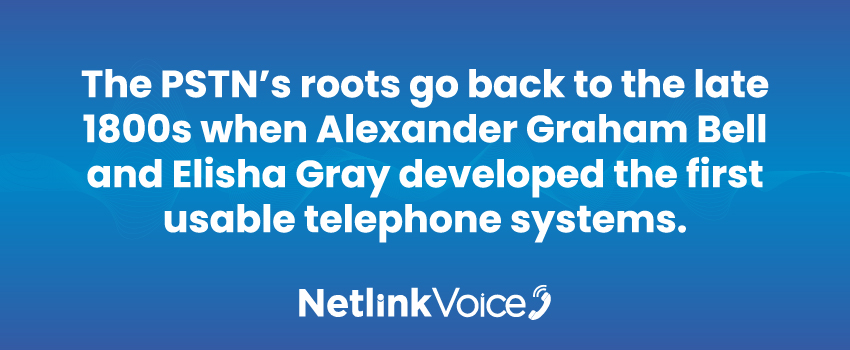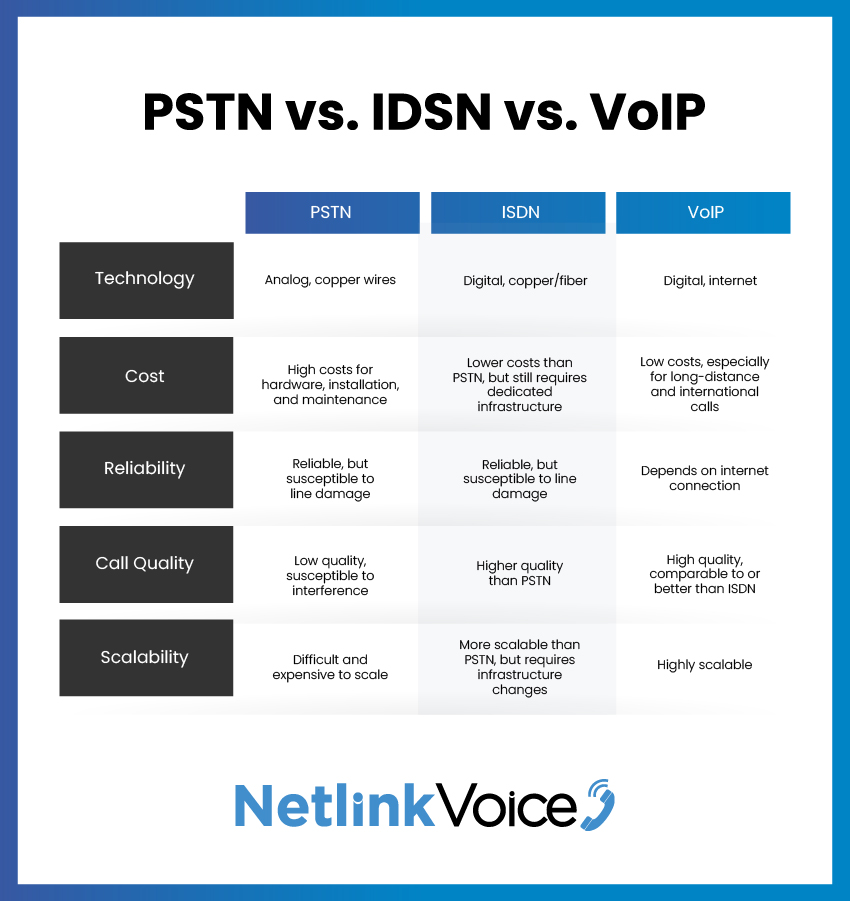TL;DR: Public Switched Telephone Network (PSTN)
- The Public Switched Telephone Network (PSTN) is the traditional, circuit-switched landline phone network built on copper lines and centralized exchanges.
- It’s reliable and has powered global voice calls for over a century, but it’s now an aging, limited technology with high costs, poor scalability, and few modern features.
- Many countries and major carriers are actively phasing out PSTN and copper infrastructure, with only a small fraction of lines expected to remain by 2030.
- Digital alternatives like VoIP and unified communications (UCaaS) offer lower costs, better call quality, mobility, and powerful features such as integrations, call recording, and voicemail-to-email.
- Businesses still on PSTN should start planning a gradual migration to cloud-based solutions like Netlink Voice’s ConnectWare to modernize communications and future-proof their phone systems.
The Public Switched Telephone Network (PSTN) is the traditional global network that facilitates landline telephone communications. Initially developed in the late 19th century, it has evolved from manually operated switchboards to a complex system of automated exchanges.
PSTN operates as a circuit-switched network, meaning that a dedicated communication path is established between two endpoints for the duration of the call. This system relies on a combination of copper wires, fiber-optic cables, and satellites to route voice signals across local, national, and international distances.
At the heart of PSTN’s functionality are the local and regional exchanges that manage the flow of calls. When a call is placed, it passes through a series of switches at these exchanges to create a continuous connection between the caller and the receiver.
While the system originally used analog signals to transmit voice, modern PSTN has adopted digital switching in many parts of the network, converting voice into digital data for more efficient long-distance communication. Despite its analog origins, PSTN has remained relevant for over a century, serving as the backbone of voice communication worldwide.
In recent years, the rise of digital alternatives like VoIP (Voice over Internet Protocol) and mobile networks has led to a gradual decline in the use of PSTN. An estimated 56% of organizations have already adopted or are planning to adopt unified communications solutions,1 indicating a significant shift away from the PSTN.
However, it still plays an important role in regions where digital infrastructure is limited or where a more reliable, stable telephone system is required. While it no longer serves as the cutting-edge of telecommunications, PSTN remains a critical component of global communication infrastructure.
In this blog, we’ll discuss everything you need to know about the PSTN and why more businesses are moving away from this aging technology.
What Is PSTN?
PSTN phone line is a connection on the Public Switched Telephone Network, the global, operator-run system for landline calls. It uses circuit switching to create a dedicated path for each call and carries voice over copper, fiber, and satellite across local, national, and international networks.
While the PSTN has been a reliable system, it is being phased out due to its limitations and the availability of more advanced technologies. Many countries, including New Zealand, Australia, and the United Kingdom, have already set deadlines for the complete decommissioning of their PSTN infrastructure.
The History Of PSTN
The roots of the PSTN go back to the late 1800s when inventors Alexander Graham Bell and Elisha Gray developed the first usable telephones. These early telephones used copper wires and could only communicate point-to-point.
Manual switchboards became popular in the late 1800s and early 1900s. They enabled operators to manually connect calls by plugging and unplugging cords – a significant improvement over point-to-point communication, as it allowed for the creation of larger networks and more efficient call routing. Automated switching later replaced manual call handling, giving rise to the PSTN network as we know it today.
During the 1970s and 1980s, digital switching systems replaced analog PBX systems. This offered better call quality and data transmission over telephone lines, as well as the ability to integrate new features such as caller ID and voicemail.
The PSTN remains an old and limited technology despite these innovations, resulting in the development of Voice over Internet Protocol (VoIP) phones. The emergence of IP telephony marked a major shift in the telecommunications industry, as it allowed voice calls to be transmitted over the internet rather than outdated copper lines.

How PSTN Works
The Public Switched Telephone Network is a combination of worldwide telephone networks, including cable systems, telephone lines, fiber optic cables, cellular networks, and more. When a call is made, the PSTN system creates a temporary, dedicated connection between the two endpoints, ensuring that voice data is transmitted without interruption or interference.
Here’s how it works:
Telephone To Central Office
When you dial a phone number, your telephone set converts your voice into electrical signals and sends them over cables to a nearby terminal. This terminal collects the signals and determines where they should be sent next.
Central Office Call Routing
The call then goes to a central office (for local calls) or a tandem office (a hub that routes calls to other central offices). The central office routes the call through fiber optic cables that convert the electrical signals into light pulses.
Central Office To The Terminating Number
The relevant central office picks up the light pulses, converts them back into electrical signals, and sends them to the target terminal. The destination terminal then forwards the call as sound waves to the appropriate telephone number.
This dedicated circuit approach is known as circuit switching, which is different from the packet-switching technology used in modern communication systems like VoIP. In a circuit-switching phone system, a fixed amount of bandwidth is reserved for each call to provide a consistent, reliable connection throughout the duration of the call.
PSTN Architecture Explained
The PSTN architecture consists of several components that work together to transmit voice signals, including:
Central Office
The central office (CO), also known as the local exchange, connects subscribers to a PSTN phone line. It identifies the number dialed and routes the call to the desired destination. Central offices are equipped with switches that facilitate the connection between the caller and the recipient.
Tandem Office
A tandem office, or junction network, is made up of multiple local exchanges within a large geographical area. Tandem offices act as intermediaries, receiving external calls from one central office and routing them to another central office closer to the destination.
Toll Office
Toll offices are responsible for managing the switching and routing of calls between different regions or states within the same country. When someone dials a number outside the geographical area of a local exchange or tandem office, it gets routed to a toll office, which handles long-distance domestic calls.
International Gateway
International gateways route calls outside the country. International gateways serve as the entry and exit points for international phone calls, connecting the domestic PSTN infrastructure to international networks.
Trunk Lines
Trunk lines are high-capacity circuits that carry multiple calls simultaneously between switching centers. They provide the necessary bandwidth for transmitting large volumes of voice data between different components of the PSTN.
Signal Transfer Points (STPs)
STPs are specialized packet switches that facilitate the exchange of signaling information between different components of the PSTN. They play a crucial role in call setup, management, and teardown by transmitting control signals across the network.
Service Control Points (SCPs)
SCPs are databases that store information related to subscriber services and call routing. They work in conjunction with STPs to provide advanced features and services, such as call forwarding, caller ID, and number portability.
Signaling System 7 (SS7)
SS7 is a global telecommunications protocol used to establish and manage voice calls in PSTN. It enables the exchange of signaling information between network components, facilitating call setup, routing, and teardown.
PSTN Alternatives For Businesses
The phase-out of the PSTN has accelerated in recent years, driven in part by regulatory changes and decisions by major telecommunications providers to retire their copper line infrastructure. In 2018, the Federal Communications Commission (FCC) announced that it would no longer require providers to offer copper-based landline services, effectively removing a regulatory barrier to the transition away from traditional telephone networks.
This move by the FCC has paved the way for popular telephone service providers to phase out their copper lines and focus their investments on fiber optic networks and VoIP services. Major providers such as AT&T, Verizon, and CenturyLink have announced plans to retire their copper line infrastructure in various regions, citing the high costs of maintenance and the increasing demand for higher-speed internet and voice services. Experts predict that only around 5% of PSTN lines will remain active by 2030.2 As a result, businesses that currently rely on fixed-line telephones are facing increasing pressure to explore alternative solutions. Here’s a brief overview of two popular PSTN alternatives and how they differ from legacy telephone service:

Integrated Services Digital Network (ISDN)
ISDN is a telecommunications system that offers higher quality, faster, and more reliable voice, data, and video transmission compared to the PSTN. It operates over the same copper-based telephone lines or fiber optic cables but uses digital signals instead of analog signals.
ISDN provides higher bandwidth than the PSTN and supports simultaneous voice and data transmission, making it better suited for applications such as video conferencing and online collaboration.
However, ISDN technology is considered outdated and has been largely replaced by more modern alternatives like VoIP and broadband internet connections. While it offered improvements over traditional landline phones in its time, it still relied on dedicated circuits and had limitations in terms of scalability and flexibility.
Voice over Internet Protocol (VoIP)
VoIP is a digital technology that transmits voice signals using an internet connection instead of copper wires. VoIP digitizes voice calls and transmits them over the internet, allowing for more efficient use of bandwidth and resources.
VoIP offers several advantages over a traditional telephone system, including:
-
- Cost Savings: VoIP calls are usually more affordable than traditional phone calls, especially for international and long-distance calls.
-
- Scalability: Compared to the PSTN, adding new lines or extensions to a VoIP phone system is relatively easy and cost-effective.
-
- Mobility: VoIP lets users make and receive phone calls from any internet-connected device, enabling greater mobility and flexibility.
-
- Voice Quality: VoIP transmits digital voice signals over high-bandwidth internet connections, resulting in better voice quality compared to traditional landline phone systems.
-
- Advanced Features: VoIP systems often include advanced features such as voicemail-to-email, call recording, virtual faxing, and seamless integration with other communication tools.
VoIP offers many advantages, but it also has some potential drawbacks – including dependence on a reliable internet connection and potential security vulnerabilities if not properly configured. However, the continued growth and improvement of internet connectivity and security measures have made VoIP an increasingly popular alternative to legacy business phone system solutions.
The Drawbacks Of PSTN
While the Public Switched Telephone Network has been a reliable system for voice communications, it presents several challenges for businesses:
High Costs
Setting up and maintaining PSTN phone services can be expensive for businesses, especially as they grow. Each employee requires a dedicated phone line, and businesses often need to purchase and maintain a Private Branch Exchange (PBX) system, which can be costly. The costs associated with a PSTN system can include equipment purchases, installation fees, monthly line rental charges, and long-distance or international calling fees.
Lack Of Scalability
Scaling a PSTN network is a complex and time-consuming process. Adding new lines requires installing additional hardware and wiring, which can be disruptive and expensive. This lack of scalability can be a significant challenge for businesses that experience rapid growth or have fluctuating communication needs.
Modern communication solutions like VoIP offer much greater scalability, as adding new lines or extensions can often be done quickly and with minimal additional hardware or infrastructure changes.
Limited Calls
With the PSTN, outgoing calls are limited to the local exchange, and employees can only make and receive calls from the physical location where the system is set up. This lack of mobility can be a huge disadvantage for modern businesses, where remote work and flexible communication are increasingly important.
PSTN systems also typically don’t support advanced call forwarding or routing features, further limiting the flexibility and efficiency of communication within an organization.
Fewer Features
PSTN providers typically offer limited features compared to modern communication solutions. Many include basic features like caller ID and call waiting, but more advanced features such as video conferencing and intelligent routing are often lacking.
Digital technologies like unified communications solutions include several advanced features out of the box, such as voicemail-to-email, call recording, virtual faxing, and seamless integration with other communication tools and productivity software.
Difficult Integrations
PSTN systems operate in isolation, making it difficult to integrate them with other business tools and applications. Modern communication solutions like VoIP and unified communications solutions can integrate with a wide range of business applications, including productivity suites and customer relationship management (CRM) software. This integration enables more efficient workflows and better collaboration among teams.

FAQs
Here are some frequently asked questions about the Public Switched Telephone Network:
What Is A PSTN Phone Line?
A PSTN phone line is a landline service that carries calls over the Public Switched Telephone Network, a global, operator-run system using circuit switching to create a dedicated path for the duration of each call.
How Does A PSTN Phone Line Work?
When you place a call, circuit switching establishes a temporary, dedicated route between endpoints. Your voice travels as an analog or digitized signal over copper, fiber, and sometimes satellite links until the call ends.
What’s The Difference Between PSTN And VoIP?
PSTN uses circuit-switched paths on carrier networks, while VoIP transmits voice as data packets over IP networks. PSTN emphasizes dedicated call paths and legacy infrastructure; VoIP emphasizes flexibility, bandwidth efficiency, and internet connectivity.
Is A PSTN Phone Line Reliable During Power Outages?
Traditional copper PSTN lines often continue working because power can be supplied from the central office. In fiber or IP-based last-mile setups, service typically needs on-premises backup power to keep phones active.
How Do I Know If I Have A PSTN Line?
If your phones are connected to traditional phone cords (RJ-11) and not Ethernet cords (RJ-45), you likely have a PSTN line. Additionally, if your phone line remains in service during a power or internet outage, it’s a PSTN line. PSTN lines are independent of external power sources, making them more reliable for emergency calls.
Are PSTN Calls Encrypted?
No, PSTN calls are not encrypted. While the PSTN is considered a secure form of voice communication, the data transmitted is not encrypted. The lack of encryption means that PSTN calls could be intercepted and listened to by unauthorized parties with the right equipment and access.
What’s The Difference Between Direct Inward Dialing (DID) And PSTN?
DID is a telephone feature that allows businesses to assign unique phone numbers to employees without purchasing multiple phone lines, while the PSTN is the telephone network itself. DID is a service that operates on top of the PSTN infrastructure, allowing for more efficient use of phone lines and better organization of incoming calls.
Is The PSTN More Expensive Than VoIP?
Yes, the PSTN is generally more expensive than VoIP for businesses.
With PSTN, businesses often need to invest in expensive hardware like PBX systems and dedicated phone lines for each employee, which can quickly add up as the company grows. The setup and maintenance costs of PSTN systems, along with the charges for long-distance and international calls, make it a more costly option compared to VoIP.
Can A PSTN Phone System Work With VoIP?
While PSTN and VoIP are different technologies, it’s possible to integrate them using an Analog Telephone Adapter (ATA). An ATA converts analog signals from PSTN phones into digital signals that can be transmitted over an internet connection, allowing businesses to gradually transition from PSTN to a VoIP network without completely replacing their existing phone hardware. However, integrating PSTN and VoIP can be complex and may not provide all the benefits and features of a pure VoIP system.
Keep in mind that the PSTN is an aging technology, and many countries are actively working towards phasing it out in favor of more modern communication systems like VoIP. As a result, businesses that rely heavily on the PSTN may need to plan for a complete transition to VoIP or other internet telephony solutions in the near future to ensure they have access to the latest capabilities while maintaining reliable communication services.
Replace Your Outdated Phone System With Netlink Voice
The Public Switched Telephone Network (PSTN) has been the mainstay of business communications for decades, but it’s now being phased out in favor of newer solutions. Modern communication solutions that leverage VoIP offer several advantages over legacy copper lines, making them ideal for meeting today’s business communication needs.
If you’re ready to modernize your phone system, look no further than ConnectWare by Netlink Voice. Our cloud-based unified communications platform gives your team the freedom and flexibility they need to step away from the desk and communicate on any device, anywhere. By partnering with Netlink Voice, you gain access to a feature-rich, cost-effective UCaaS solution – supported by a provider who picks up the phone when you call.
Reach out to our experts today to get started!
Sources:

